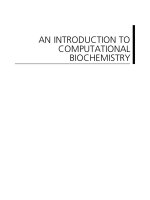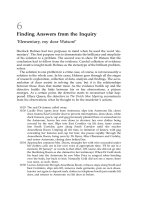Introduction to Clinical Biochemistry: Interpreting Blood Results pot
Bạn đang xem bản rút gọn của tài liệu. Xem và tải ngay bản đầy đủ của tài liệu tại đây (10.43 MB, 54 trang )
2
Dr. Graham Basten
Introduction to Clinical Biochemistry
Interpreting Blood Results
3
Introduction to Clinical Biochemistry: Interpreting Blood Results
© 2011 Dr. Graham Basten & Ventus Publishing ApS
ISBN 978-87-7681-673-5
Introduction to Clinical Biochemistry:
Interpreting Blood Results
4
Contents
Contents
About the Author 7
Introduction to Clinical Biochemistry: Interpreting Blood Results: 9
1 Laboratory tests: Interpreting Results 10
1.1 A typical blood sciences service 10
1.2 Variables that may aect a result: Analytical 10
1.3 Standards 11
1.4 Quality Control: Within batch, between batch, external 11
1.5 Control Plots 13
1.6 Precision, Accuracy, Bias 14
1.7 Variables that will aect a result: Physiological 16
1.8 Summary 22
2 Overview of tests 23
2.1 Summary 25
3 e blood cells and liquid component: Full Blood Count (FBCs) 26
3.1 Red Blood Cell Indices 27
3.2 White Blood Cell Indices 31
Introduction to Clinical Biochemistry:
Interpreting Blood Results
5
Contents
3.3 Clotting Indices 32
3.4 Summary 34
4 Autoimmune and inammation 35
4.1 Inammation and CRP 37
4.2 Plasma Viscosity 37
4.3 Erythrocyte Sedimentation Rate 38
4.4 e inammation trilogy 38
4.5 Autoimmune Diseases 38
4.6 Summary 39
5 Liver function test (LFTs) and Enzymes 40
5.1 Enzymes 41
5.2 Bilirubin 43
5.3 Liver Enzymes 44
5.4 Summary 45
6 Kidney function tests and electrolytes (U&Es) 46
6.1 Electrolytes 47
6.2 Urea and Creatinine 47
6.3 Glomerular ltration rate (GFR) 48
6.4 Uric acid and gout 48
6.5 Summary 48
Introduction to Clinical Biochemistry:
Interpreting Blood Results
6
Contents
7 e bone and calcium (bone prole) 49
7.1 Corrected calcium 49
7.2 Calcium control 49
7.3 Bone diseases 51
7.4 Summary 52
8 Summary 53
Introduction to Clinical Biochemistry:
Interpreting Blood Results
7
About the Author
About the Author
Dr. Graham Basten
De Montfort University
Associate Head of School
School of Allied Health Sciences
Faculty of Health & Life Sciences
Room H1M-2 Hawthorn Building
Leicester LE1 9BH
E-mail:
Phone: 0116 207 8639
Fax: 0116 250 6411
Website: />Twitter: />Academic Blog: />Research Blog: />Short Biography
Dr Graham Basten is Associate Head of the School of Allied Health Sciences at De Montfort University (UK). He holds
a PhD from the UK government’s Institute of Food Research and has researched and lectured extensively over the past
10 years on clinical biochemistry, nutrition and folate at the Universities of Sheeld and Nottingham (UK). He is a De
Montfort University Teacher Fellow and has been nominated for the Vice Chancellor’s Distinguished Teaching Award. As
a senior lecturer in Clinical Chemistry, and as leader of the undergraduate Projects module, this expertise and experience
is transferred to the concise introductory textbooks written for Book Boon.
Select research publications
1. Blood folate status and expression of proteins involved in immune function, inammation, and coagulation:
biochemical and proteomic changes in the plasma of humans in response to long-term synthetic folic acid
supplementation. Duthie SJ, Horgan G, de Roos B, Rucklidge G, Reid M, Duncan G, Pirie L, Basten GP,
Powers HJ. J Proteome Res. 2010 Apr 5;9(4):1941-50
2. Sensitivity of markers of DNA stability and DNA repair activity to folate supplementation in healthy
volunteers. Basten GP, Duthie SJ, Pirie L, Vaughan N, Hill MH, Powers HJ. Br J Cancer. 2006 Jun
19;94(12):1942-7. Epub 2006 May 30
Introduction to Clinical Biochemistry:
Interpreting Blood Results
8
About the Author
3. Associations between two common variants C677T and A1298C in the methylenetetrahydrofolate reductase
gene and measures of folate metabolism and DNA stability (strand breaks, misincorporated uracil, and DNA
methylation status) in human lymphocytes in vivo. Narayanan S, McConnell J, Little J, Sharp L, Piyathilake
CJ, Powers H, Basten G, Duthie SJ. Cancer Epidemiol Biomarkers Prev. 2004 Sep;13(9):1436-43
4. Eect of folic Acid supplementation on the folate status of buccal mucosa and lymphocytes. Basten GP, Hill
MH, Duthie SJ, Powers HJ. Cancer Epidemiol Biomarkers Prev. 2004 Jul;13(7):1244-9
Introduction to Clinical Biochemistry:
Interpreting Blood Results
9
Preface
Introduction to Clinical Biochemistry:
Interpreting Blood Results:
is book is primarily aimed at undergraduate students reading medicine, nursing and midwifery, and subjects allied to
health. It will also be useful to professionals undergoing continuing professional development (CPD) or changing to an
extended role who require a background covering physiology and pathology for haematology and biochemistry. Since the
book uses “example boxes” to explain complex terms in lay language, it should also be accessible to patients and people
with a non-clinical background but an interest in the subject. To facilitate this, each chapter has an introductory paragraph
guiding the reader to the example boxes if needed and a summary section.
Chapter 1 examines how to interpret results, with the remaining broadly representing a section of the body or a disease
type with chapter 9 as a summary. is should enable a read from cover to cover, or equally as a reference, as each chapter
is independent. As this book is an introduction to the area, you may be inspired for further training and reading. ere
are many excellent resources online, too many to list here, although I would recommend starting with your countries’
primary care provider organisation, respected charities, reputable training companies and higher education institutes for
further information.
Study with the textbook using key concepts (these are the headings and sub headings). List the key concepts and attempt
to write a few words about each section, and then refer back to the text book.
Disclaimer
Reference ranges, normal, abnormal and cut-o values are provided as examples to explain a term or disease setting, these
are not transferable to the reader’s own setting. Similarly, denitive diagnosis, prescribing, treatment, monitoring times
are excluded; the reader should seek this information from their primary care provider or trusted sources. Case studies
are used throughout but should not be used as the basis for a diagnosis. Neither the author nor the publisher accepts any
liability for the reader using the information in the book inappropriately.
Introduction to Clinical Biochemistry:
Interpreting Blood Results
10
Laboratory tests: Interpreting Results
1 Laboratory tests: Interpreting
Results
is chapter introduces the key steps in ensuring that the blood result is as accurate as possible. Whilst true that in most
modern hospitals much of the calculations in this chapter will be automated and produced by computer programmes, an
understanding of the basic principles is to be encouraged. e non-clinical reader may nd the section about reference
ranges most useful.
1.1 A typical blood sciences service
Clinical chemistry, chemical pathology and clinical biochemistry are names given to the study of biochemical events or
parameters in the body. Increasingly and intuitively, this study has merged with certain aspects of haematology (blood
cells and liquid). is has created a new eld called “blood sciences” which encompasses sections of both disciplines to
create a more logical service to users. Typically a blood science service will have a laboratory manager who will oversee
the production of reliable results, and will usually be state registered. Logistically, there will be areas for sample reception,
analysis, reporting data and storage of material.
1.2 Variables that may aect a result: Analytical
ere are two factors can aect the result of a blood test, analytical or physiological. Analytical error is caused by the
service, typically the machine or process which produces the result. Physiological error is caused by people, typically how
the blood is collected, whether the patient was fasted or taking medication.
1.2.1 Analytical sensitivity and specicity
Each blood test will have an experimental technique to produce the result. Confusingly, two sets of sensitivity and
specicity exist in blood sciences; they have totally dierent meanings and refer to either analytical and physiological (or
diagnostic) measures.
Analytical sensitivity refers to the detection limit of the experiment. is is the smallest amount of material of interest
that the experiment can detect. As technology has developed it is increasingly easier to measure smaller quantities of
material, although at small levels the accuracy and precision may be lower and this can be measured using quality control.
Introduction to Clinical Biochemistry:
Interpreting Blood Results
11
Laboratory tests: Interpreting Results
Analytical specicity refers to whether any other similar chemicals interfere with the test.
1.3 Standards
Most tests will have a type of standard to measure quality and ensure the result is as accurate as possible. ere are usually
two types either primary or secondary. A primary standard is of a known quantity and is oen produced externally with
certication, they are used to characterise the upper and lower parameters or sensitivity of the test. Oen labelled as high,
low, calibrators, controls they can also be used to calibrate on-board soware of automated analysers. ey have a clear
advantage in that they can be stored long term and provide a known amount or concentration; a clear disadvantage is
that they are usually in a “pure” matrix such as saline or a buer. I’m condent in declaring that there is no human alive
with blood constituted from 100% saline. Hence the need for secondary standards which are usually samples of plasma,
serum or whole blood to ensure that test is suitable and consistent in the chosen matrix. is forms the basis for within
and between batch variation (see chapter 1.4)
1.4 Quality Control: Within batch, between batch, external
Each blood test result produced by an accredited laboratory will have quality control procedures in place to ensure that
inevitable variations in machine, sta, and temperature do not aect the result.
1.4.1 Within batch variation
is is used to evaluate how good the technique is at giving the same result for identical samples in one attempt. is
method oen identies whether a machine has bias towards a certain location on the rotor.
Figure 1.1 shows a typical rotor which has 11 samples ready to analyse. H and L are primary standards (see chapter 1.4)
and each yellow circle represents the same sample in replicate.
Introduction to Clinical Biochemistry:
Interpreting Blood Results
12
Laboratory tests: Interpreting Results
With the results from the experiment we can calculate the mean and standard deviation (SD) of the 9 identical yellow
samples. Using the mean and standard deviation we can calculate the %Coecient of Variance (CV)= ((SD /Mean)x100).
is data is used to create the Y-Axis of a control plot (see 1.5). A common misconception is that a low CV is by default
better than a higher one. e most important thing is that to consider is if the CV changes.
Figure 1.1: Within batch variation
Introduction to Clinical Biochemistry:
Interpreting Blood Results
13
Laboratory tests: Interpreting Results
1.4.2 Between batch variation
is is used to evaluate how good the technique is at giving the same result on separate attempts. It is used to evaluate for
example, if the machine or indeed a dierent operator will give a dierent result at a dierent time. Figure 1.2 shows the
next two rotors done aer our within batch test. ey too have H and L standards (primary) and the same yellow sample
we used for within batch (secondary) and it is this data (either from the primary, secondary, or both) which is used to
create the X-Axis of a control plot (see 1.5) However, we also have the green sample which are dierent patient’s samples
and the control plot will inform the service if the green results are suitable to be released as accurate
Figure 1.2: Between batch variation
1.4.3 External quality control
is is used to evaluate if you get a dierent result if the test is done at a dierent site. Typically, a national organisation
will send the same sample to dierent laboratories accredited to produce blood results and measure how similar the
returned result is.
1.5 Control Plots
ere are two commonly used control plots, either Levey Jennings or Westgard and both inform the service of the accuracy
of the test over time. Excellent online resources for both these plots exist, accessible by any good search engine, and will
provide further reading. ey usually have a range of the mean plus or minus 3SD which on normally distributed data is
99.7% condence. Test results for a patient sample which fall outside of this range are to be considered for rejection. e
plots also inform the test is over or under reporting results over time.
Introduction to Clinical Biochemistry:
Interpreting Blood Results
14
Laboratory tests: Interpreting Results
Figure 1.3: Example of a control plot. On the Y-axis is the mean plus and minus 3 SD determined by the within batch, on the X-axis is the
mean value for each between batch test. The red dot is a mean value which is outside the 3SD range and may be considered for rejection. Each
blue dot (x10) is the mean value of the between batch over 10 days, a blue dot per day, this shows that this test is under reporting. Think about
what a test that over reported may look like?
1.6 Precision, Accuracy, Bias
Precision, Accuracy, Bias are terms used to describe certain parameters of the test. Precision is how close repeated measures
of the same sample lie, accuracy is how close the value reported is to the true value and bias describes variables which
may aect precision and accuracy and lead to over and under reporting or large random background changes.
Introduction to Clinical Biochemistry:
Interpreting Blood Results
15
Laboratory tests: Interpreting Results
Figure 1.4: Robin Hood at the pageant
Introduction to Clinical Biochemistry:
Interpreting Blood Results
16
Laboratory tests: Interpreting Results
1.7 Variables that will aect a result: Physiological
Sections 1.2 to 1.6 looked at how the machinery and experimental method (analytical) can produce errors in the results.
In the remainder of the chapter issues caused by people will be explored. Such as, how blood is collected and stored, the
dierence between plasma and serum, using reference ranges and clinical sensitivity and specicity.
1.7.1 Blood collection and storage techniques
Tourniquets are oen used to collect blood samples as they block venous return and cause dilatation enabling identication
of entry points. However, due to this phenomenon typically, for each minute of use due to loss of water and electrolytes
from plasma, plasma protein increases by up to 1%. e stasis of blood ow can produce dierent metabolic products such
as lactate, and, if the patient is asked to clench their st this may cause an artifactual hyperkalemia (elevated potassium
levels). Clearly these disadvantages do not justify the non-use of tourniquets but may be worth considering if results
appear unlikely based on symptoms or unreliable.
Other problems include poor patient identication, samples taking more than 72 hours to be transported to the service,
incorrect temperature or not protected from light. To reduce this error each test will have a specic blood collection protocol.
1.7.2 The dierence between plasma and serum
Serum is thought to be a derivative word for “whey” as in “curds and whey” which are the products formed when milk
is allowed to clot. e whey is the liquid component whilst the curds are the solid parts. If blood is allowed to clot the
liquid component is therefore called serum, if blood is prevented from clotting then the liquid component is called plasma
(FIG. 1.6).
Introduction to Clinical Biochemistry:
Interpreting Blood Results
17
Laboratory tests: Interpreting Results
Figure 1.6: The dierence between plasma and serum
e main disadvantage of using serum is that the blood has already participated in clotting. In other words, a series of
metabolic processes have occurred aer the sample was collected but before the sample was measured and this can lead
to error in measures like potassium, phosphate, magnesium, aspartate aminotransferase and lactate dehydrogenase. As
we will see in alter chapters these are key measures of acute and chronic disease. e advantages of serum is that it can
be used to measure constituents which would be destroyed or compromised by the anticoagulant chemicals used in the
preparation of plasma samples.
e main disadvantages of using plasma (blood which has not clotted due to the addition of anticoagulants) is the
anticoagulants can interfere with certain analytical methods or change the concentration of the constituents to be measured.
e advantages of using plasma samples include “cleaner” samples which have not undergone the clotting process, time
saving and a higher yield (up to 20 %)
1.7.3 A haemolysed sample.
If following centrifugation the plasma or serum looks reddish rather than straw yellow, it is likely the sample has
haemolysed (FIG. 1.7). In a haemolysed sample some of the red blood cells have lysed (broken open) and their contents
have now contaminated the plasma or serum sample. is will cause error in reporting amongst others elevated potassium,
magnesium and phosphate. Some analytical methods may be able to negate the eect of the haemolysed sample. Common
causes of a haemolysed sample are collection needle gauge too narrow, over vigorous shaking of the sample, underlying
haematological disorder, red cells isolated for storage and then stored in water or a non isotonic solution and over physical
dispensing of blood from hypodermic syringe to collection tubes.
Introduction to Clinical Biochemistry:
Interpreting Blood Results
18
Laboratory tests: Interpreting Results
Figure 1.7: A haemolysed sample
Introduction to Clinical Biochemistry:
Interpreting Blood Results
19
Laboratory tests: Interpreting Results
1.7.4 Reference ranges
Most people are comfortable with the idea of reference ranges, but what do actually tell us, or rather don’t tell us? To
create a reference range a number (usually over 120) of volunteers are matched for factors (table 1) and the analyte is
measured. Firstly, most ranges have a 95% condence which means that the top 2% of values and the bottom 2% of values
are omitted, so it is possible to be healthy but outside the reference range, you are just at the very top or the very bottom
which aren’t shown (see 1.7.6). Secondly, you should use ranges from invalidated sources with great care as ranges can
vary with age and sex for example.
Table 1 shows common attributes which are matched to create, or can aect a reference range.
1.7.5 Clinical cut o values
Reference ranges are generally used to identify a range of “normality” a value outside of this may justify further investigation.
Values that are outside reference ranges may be matched to case control studies and attributed a disease progression status
using clinical cut o values.
Introduction to Clinical Biochemistry:
Interpreting Blood Results
20
Laboratory tests: Interpreting Results
1.7.6 Clinical sensitivity and specicity
In order to describe clinical sensitivity and clinical specicity, remember these are dierent to analytical sensitivity and
specicity, we need to think about how references ranges for healthy and diseased patients interact. Figure 1.8 shows
a healthy reference range in green and a diseased reference range in red with TN, FP, TP and FN annotated (table 2).
erefore, clinical specicity relates to whether the test can report someone without the disease correctly as being “healthy”,
conversely clinical sensitivity is whether the test can report someone with the disease correctly as being “diseased”. To
calculate use the following equations Sensitivity = TP/TP+FN and Specicity = TN/TN+FP
Introduction to Clinical Biochemistry:
Interpreting Blood Results
21
Laboratory tests: Interpreting Results
Table 2: Summary of TN, FP, TP and FN.
Figure 1.8: Clinical specicity and sensitivity.
Introduction to Clinical Biochemistry:
Interpreting Blood Results
22
Laboratory tests: Interpreting Results
e cut o value is the point at which people change from being assigned healthy to disease or the reverse. If we move
the cut o value to the far right then everyone who is healthy will be reported as healthy but more diseased people will
be missed (wrongly assigned healthy). If we move the cut o value to the far le then everyone who is diseased will be
reported as diseased but more healthy people will be wrongly assigned as diseased. It is at this point that factors like cost,
screening, reliability of data and most importantly medical ethics are involved, is telling someone they have cancer when
they don’t as serious as missing someone who does have cancer? ese issues and the likely implications of the disease
specic intervention (surgical, drugs) will be considered.
1.8 Summary
is chapter considered factors which can aect the result. ese broadly fall into two areas analytical (machine) and
physiological (human). Starting with the machine or technique that measures the test, to the blood collection method to
variations in the person being tested the chapter highlighted common quality control measures to reduce these errors.
An understanding of how to interpret the results in an essential foundation to understand each of the subsequent tests
and theories discussed in the remaining chapters.
Introduction to Clinical Biochemistry:
Interpreting Blood Results
23
Overview of tests
2 Overview of tests
A typical blood test will aid in diagnosis, screening, evaluate prognosis and monitor interventions or disease
progress. The tests generally fall into levels (core to specialist). An increase in test level will usually be justified
by an abnormal level one test (Table 1). The tests in level one provide a broad overview of the body and will
encompass most common diseases, they are used a starting point for investigation as they are often not specific to
one pathology. The likelihood of a definitive diagnosis in increased with more specific tests in levels two and three,
these tests tend to be more complex, more expensive and may be performed at specific centres so may take longer
to receive the results. The tests, particularly level one, can also be used to exclude a diagnosis or organ by pairing
normal and abnormal results. In each subsequent chapter salient tests and case studies will use the three level
model. Some diagnosis are heavily reliant on blood test results others will have almost no use for a blood test, and
the test is used in conjunction with patient observations, clinical technology and physiology (imaging, radiography,
lung function, echocardiogram), cytology (cervical smears), microbiology (bacteria), immunology (hayfever) and
haematology (blood transfusions)
Level Typical Test
One Full Blood Count (FBC)
Urea and Electrolytes (U&E)
Liver Function Tests (LFT)
Bone Prole
Glucose
Amylase
Total protein and albumin
Thyroid Prole (TFT)
Two Folate
Vitamins i.e. B12
Hormones
Trace Elements
Three Auto-antibodies
Tumour markers
Table 3: Shows a typical structuring of common tests
Introduction to Clinical Biochemistry:
Interpreting Blood Results
24
Overview of tests
Level Test Result
1 Full Blood Count Low Red Blood Cell Number (RBC)
Low Haemoglobin (Hb)
High Mean Cell Volume (MCV) (Macrocytic)
? Macrocytic anaemia justication of further tests
2 Iron Status All markers of Iron Status Normal (this is unlikely to be out of range
as the patient is Macrocytic and most Iron anaemias are microcytic:
small MCV)
2 Folate / B12 Status Folate Low
B12 Very Low
? Macrocytic anaemia caused by either folate or B12 deciency. Causes could be:
• Dietary malnutrition or prescribed drugs (some epilepsy drugs and cancer drugs block folate)
• Alcohol dependence (because red blood cells last for 12 weeks, a macrocytic state will reect long
term alcohol intake
• Auto-immune disease
Justication of further tests
1 Liver Function Test (LFT) All results normal, so discounts heavy and prolonged alcohol intake
3 Anti-parietal cell Antibody Positive
1 U&E
Normal, this conrms that the low RBC is not due to the kidney
being unable to produce a chemical called Erythropoietin which
makes RBC
2 Glucose HB1AC
Normal, this conrms that the loss of feelings in the legs and feet
are probably not from diabetic complications
? A reasonable working diagnosis would be that this patient has Pernicious Anaemia, an auto immune destruction of
the stomach lining which impairs vitamin B12 absorption. This may take months to become symptomatic to the patient
as the body can store up to 20 months of B12. B12 is needed to make healthy red blood cells, but also to help with nerve
signals and impulses, so these patients may also have neuropathy (nerve tissue death) in their feet causing an unsteady
walk and swelling.
This patient will probably not respond to oral B12 supplementation due to the damage to the stomach so will need an
intramuscular injection of B12.
Table 4: A decision ow showing how dierent tests would be justied and worked through to arrive at a working hypothesis.
Introduction to Clinical Biochemistry:
Interpreting Blood Results
25
Overview of tests
2.1 Summary
is chapter discussed how the tests are structured based on justication. Starting with level one tests which reveal a
broad range of possible diseases, and indeed rule out numerous diseases, through to much more specic tests. In your
own area you may want to recreate Table 4 using some common diseases and tests you commonly use to help detangle
the numerous tests into a structure.
In the following chapter case studies and discussion will follow the levels of testing heoricahy.









